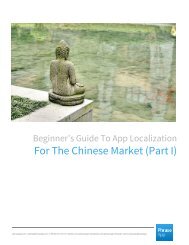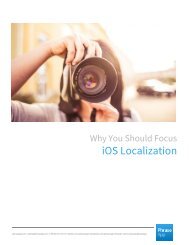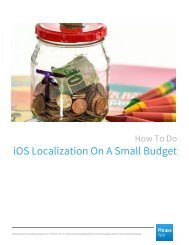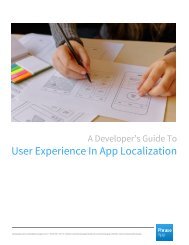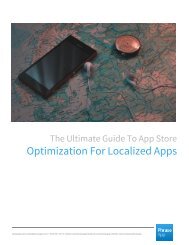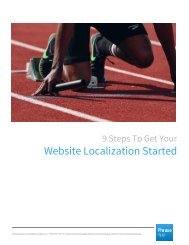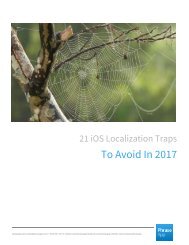The Only App Localization Tutorial You Will Ever Need
Create successful ePaper yourself
Turn your PDF publications into a flip-book with our unique Google optimized e-Paper software.
<strong>The</strong> <strong>Only</strong> <strong>App</strong> <strong>Localization</strong> <strong>Tutorial</strong><br />
<strong>You</strong> <strong>Will</strong> <strong>Ever</strong> <strong>Need</strong><br />
phraseapp.com | sales@phraseapp.com | +49-40-357-187-76 | twitter.com/phraseapp | facebook.com/phraseapp | linkedin.com/company/phraseapp
<strong>The</strong> <strong>Only</strong> <strong>App</strong> <strong>Localization</strong> <strong>Tutorial</strong> <strong>You</strong> <strong>Will</strong> <strong>Ever</strong> <strong>Need</strong><br />
Table of Content<br />
One Overview To Cover It All 3<br />
Let’s Get Started 4<br />
Why Localize An <strong>App</strong>? 5<br />
What Should <strong>You</strong> Localize? 5<br />
Return On Investment 6<br />
<strong>The</strong> Risks Of Unsuitable Cost Reduction 7<br />
Internationalization And <strong>Localization</strong> 7<br />
Getting In Early With Internationalization 8<br />
<strong>App</strong> Internationalization Challenges 9<br />
Locales – A Deeper Dive Into Language-Dependent Markets 10<br />
Android And IOS Internationalization 10<br />
Differences Between <strong>Localization</strong> And Translation 11<br />
Pseudo <strong>App</strong> <strong>Localization</strong> To Check If <strong>You</strong>r <strong>App</strong> Is Ready For Translation 11<br />
Starting <strong>The</strong> Translation 12<br />
Translation And Automation 12<br />
Testing Of <strong>App</strong> <strong>Localization</strong>s 13<br />
Marketing <strong>You</strong>r Localized <strong>App</strong> 14<br />
<strong>App</strong> Store Optimization 14<br />
Now <strong>You</strong> Can Start <strong>The</strong> <strong>App</strong> <strong>Localization</strong> Loop Again 15<br />
phraseapp.com | sales@phraseapp.com | +49-40-357-187-76 | twitter.com/phraseapp | facebook.com/phraseapp | linkedin.com/company/phraseapp
<strong>The</strong> <strong>Only</strong> <strong>App</strong> <strong>Localization</strong> <strong>Tutorial</strong> <strong>You</strong> <strong>Will</strong> <strong>Ever</strong> <strong>Need</strong><br />
Imagine. <strong>You</strong>r app in Spanish... In Swedish... In Swahili! <strong>Localization</strong> can make your app<br />
accessible to people and places anywhere on the planet. But what does localization entail?<br />
Sometimes it seems the deeper you dig, the more complex and the wider ranging the idea of<br />
localization becomes. An app localization tutorial to cover it all would be the size of a New York<br />
telephone directory. Moreover, it would be out of date before it was finished, because app<br />
localization needs are always changing.<br />
One Overview To Cover It All<br />
Here’s another approach. This tutorial gives you an overview of the critical points and the<br />
principles of localizing an app. <strong>You</strong> may be a marketer, a product manager, or a developer, and<br />
as such, you may naturally feel more concerned by some aspects more than others. However,<br />
all the points we discuss will affect you, directly or indirectly. For example:<br />
● If you are a marketer, you seek to understand and give what customers want – but you<br />
should also understand the constraints placed on the product manager, and the need for<br />
return on investment on localizations.<br />
● As a product manager, your concerns about app localization include time to market,<br />
quality, support, and profitability – balanced against the challenges developers face in<br />
making an app look and behave naturally to native speakers of a different language.<br />
● When you are a developer, software tools, processes, and programming knowledge can<br />
speed up localization of an app – yet without listening to your marketing colleague about<br />
addressing cultural and linguistic issues, your newly localized version may miss the mark<br />
with end-users.<br />
phraseapp.com | sales@phraseapp.com | +49-40-357-187-76 | twitter.com/phraseapp | facebook.com/phraseapp | linkedin.com/company/phraseapp
<strong>The</strong> <strong>Only</strong> <strong>App</strong> <strong>Localization</strong> <strong>Tutorial</strong> <strong>You</strong> <strong>Will</strong> <strong>Ever</strong> <strong>Need</strong><br />
Let’s Get Started<br />
<strong>The</strong> sections below will take you through the essentials of app localization from one end to the<br />
other:<br />
● Why app localization is necessary and what to localize<br />
● Making localization profitable, while maintaining quality<br />
● <strong>The</strong> initial phase of internationalization<br />
● <strong>The</strong> next phases of specific country localizations and translations<br />
● Checking app localizations before release<br />
● Marketing your localized app to maximize those international sales<br />
phraseapp.com | sales@phraseapp.com | +49-40-357-187-76 | twitter.com/phraseapp | facebook.com/phraseapp | linkedin.com/company/phraseapp
<strong>The</strong> <strong>Only</strong> <strong>App</strong> <strong>Localization</strong> <strong>Tutorial</strong> <strong>You</strong> <strong>Will</strong> <strong>Ever</strong> <strong>Need</strong><br />
Why Localize An <strong>App</strong>?<br />
<strong>Ever</strong>yone in your team and other stakeholders in your organization should understand why<br />
localization is being done. <strong>The</strong> following facts can help explain.<br />
● More than 50% of countries in the top ten for downloading and paying for apps are<br />
non-English speaking, says a survey by Common Sense Advisory.<br />
● More than 50% of customers around the world only buy from websites in their own<br />
language.<br />
● <strong>Only</strong> around 15% of all people on the planet speak English as a first or second language.<br />
Clearly, limiting your app to just one language version, whether English or another, cuts you off<br />
from potentially large markets. Conversely, suitable app localization can seriously boost your<br />
app sales revenues.<br />
What Should <strong>You</strong> Localize?<br />
Ideally, everything. For a given localization language, not only should the user interface and the<br />
functionality be localized, but also any resources the app makes available to the user, and any<br />
texts and graphics used to advertise or sell it. Ideally, native language speakers using a<br />
localized version of your app will assume the app was developed in their language from the<br />
ground up, because it looks so natural to them.<br />
<strong>The</strong> devil is in the details. A localization defect like using a period instead of a comma as a<br />
numerical separator (for example, 1.000 in French instead of 1,000 in English to represent one<br />
thousand) may look small to non-native users. However, it will probably be glaring for native<br />
speaker app users. As another example, the meaning of images and colors can change radically<br />
from one country to another. Consider the following: in China, red stands for good fortune, in<br />
France, communism, and in South Africa, mourning. Even app or product names can trip you<br />
up. For instance, mobile phone vendor Nokia discovered late in the day that the name of its<br />
flagship phone “Lumia” meant prostitute in Spanish. A little thought and googling can go a long<br />
way to avoid this kind of mistake.<br />
phraseapp.com | sales@phraseapp.com | +49-40-357-187-76 | twitter.com/phraseapp | facebook.com/phraseapp | linkedin.com/company/phraseapp
<strong>The</strong> <strong>Only</strong> <strong>App</strong> <strong>Localization</strong> <strong>Tutorial</strong> <strong>You</strong> <strong>Will</strong> <strong>Ever</strong> <strong>Need</strong><br />
Return On Investment<br />
Even with app localization tools and automated processes, producing different language<br />
versions of an app takes time and effort for developers, product managers, and marketers<br />
alike. It also requires funds for the translations, advertising (possibly), and ongoing<br />
maintenance. Return on investment is typically a concern. Marketers must provide sales<br />
estimates, while developers and translators must evaluate the workload. <strong>The</strong> product manager<br />
then compares returns against costs to decide if a localization is viable.<br />
<strong>The</strong>re is no standard order of app localization either. <strong>App</strong> product teams must evaluate their<br />
app on its own merits and international sales potential. Yesterday’s stock choices of localizing<br />
phraseapp.com | sales@phraseapp.com | +49-40-357-187-76 | twitter.com/phraseapp | facebook.com/phraseapp | linkedin.com/company/phraseapp
<strong>The</strong> <strong>Only</strong> <strong>App</strong> <strong>Localization</strong> <strong>Tutorial</strong> <strong>You</strong> <strong>Will</strong> <strong>Ever</strong> <strong>Need</strong><br />
into French, German, Italian, Japanese, and Spanish may no longer work. China and Brazil may<br />
offer higher potential revenues now. Also, it may make no commercial sense to localize for very<br />
small or very competitive markets.<br />
<strong>The</strong> Risks Of Unsuitable Cost Reduction<br />
Cost-cutting to try to shoehorn a localization into a budget is a delicate matter. <strong>The</strong>re may be<br />
cases where reuse of localization effort is possible. For example, much of the French language<br />
in France and in Canada is the same. In general, everything a user sees or experiences with an<br />
app should be available in that user’s native language. Mixing languages (local and default) in a<br />
user interface often makes users doubt the overall quality of the app. Similarly, skimping on the<br />
quality of translations and on checks after localization are recipes for localized app market<br />
failure.<br />
Internationalization And <strong>Localization</strong><br />
What many people loosely refer to as localization is in fact two activities: internationalization<br />
and then localization.<br />
● Internationalization of an app is the preparatory work to separate text and other<br />
user-facing content from the code of the app. <strong>The</strong> goal is to make the app itself<br />
language-independent. Hardcoded content is replaced by calls that automatically<br />
retrieve the text in the language of the user running the app. Language-dependent<br />
formatting is handled in the same way. Functions are used to automatically format<br />
numbers, dates, and quantities, and display them correctly in each localized version. <strong>The</strong><br />
internationalization of an app makes it considerably easier to estimate the amount of<br />
translation work needed to produce a localized version. <strong>The</strong>refore, it also helps see which<br />
localizations are likely to give a better return on investment.<br />
● <strong>Localization</strong> involves the translation of the separated content into a given language, like<br />
Spanish or Korean. Ideally, developers will do the internationalization (“i18n” for short) of<br />
their app just once for several different individual language localizations (“l10n”)<br />
afterwards. Some people refer to “transcreation” rather than translation, indicating that<br />
phraseapp.com | sales@phraseapp.com | +49-40-357-187-76 | twitter.com/phraseapp | facebook.com/phraseapp | linkedin.com/company/phraseapp
<strong>The</strong> <strong>Only</strong> <strong>App</strong> <strong>Localization</strong> <strong>Tutorial</strong> <strong>You</strong> <strong>Will</strong> <strong>Ever</strong> <strong>Need</strong><br />
text, images, screen layouts, and even app behavior may all need to be localized when<br />
producing a version of the app for another language.<br />
Getting In Early With Internationalization<br />
With good planning, internationalization costs of an app can be minimized by making the<br />
internationalization process part of the app design and development. Like bug fixes, the earlier<br />
internationalization is done in the app’s life cycle, the more cost-efficient it is. Operating<br />
systems like Android and iOS now make internationalization capability an integral part of their<br />
platform. One main language-independent version of the app can be managed with sets of<br />
resource files (text, graphics, etc.) corresponding to the default language (for example, English)<br />
and to each localization language. By comparison, internationalizing an existing app may have<br />
an incidence on costs (higher) and quality (lower). Back in the 1980s, Lotus 1-2-3 lost its market<br />
lead in Europe to Microsoft Multiplan, because it took Lotus 1-2-3 two years to disentangle user<br />
text strings from its application code.<br />
phraseapp.com | sales@phraseapp.com | +49-40-357-187-76 | twitter.com/phraseapp | facebook.com/phraseapp | linkedin.com/company/phraseapp
<strong>The</strong> <strong>Only</strong> <strong>App</strong> <strong>Localization</strong> <strong>Tutorial</strong> <strong>You</strong> <strong>Will</strong> <strong>Ever</strong> <strong>Need</strong><br />
<strong>App</strong> Internationalization Challenges<br />
Marketing takes the lead in identifying the markets in which your app is to be offered. <strong>The</strong> next<br />
step is for marketing to establish cultural and country factors that could affect localized<br />
versions, to make sure these are taken into account in the internationalization. For example,<br />
suppose your plan is to make localized versions that will only address Spanish-speaking market.<br />
<strong>You</strong> may then choose to exclude any time spent on right-to-left internationalization that would<br />
be otherwise required for languages like Arabic and Hebrew, but not Spanish. Other<br />
considerations include:<br />
● Different character sets and symbols, that your app would need to handle accordingly<br />
● Vertical language scripts for certain Asian languages<br />
● Languages with characters that change shape as the context changes<br />
phraseapp.com | sales@phraseapp.com | +49-40-357-187-76 | twitter.com/phraseapp | facebook.com/phraseapp | linkedin.com/company/phraseapp
<strong>The</strong> <strong>Only</strong> <strong>App</strong> <strong>Localization</strong> <strong>Tutorial</strong> <strong>You</strong> <strong>Will</strong> <strong>Ever</strong> <strong>Need</strong><br />
● <strong>The</strong> use of capitals<br />
● Different language rules for ordering/sorting lists<br />
● Numeral systems and formats<br />
● <strong>The</strong> way plurals are formed (other language plural formats can be more complex than<br />
English)<br />
● Variations in the type and format (like spacing) of punctuation<br />
● Keyboard shortcuts that may be unavailable in another language<br />
Locales – A Deeper Dive Into Language-Dependent<br />
Markets<br />
Within a given country or region, there may be several languages spoken. China, Belgium, and<br />
Switzerland are all examples. Alternatively, one language like English may be declined in several<br />
country variations: for instance, US English, UK English, Australian English, and so on. <strong>The</strong><br />
combination of a language (English or “en”) and a country (US) gives the locale (en-US).<br />
<strong>Localization</strong> plans should refer specifically to locales, when they make a difference in the way<br />
the user interface is displayed (for example, when displaying dates in the case of US or UK<br />
English.)<br />
Android And IOS Internationalization<br />
<strong>The</strong> two most popular platforms for mobile apps, Android and iOS, are examples of how<br />
modern operating systems are building in capabilities to help developers create<br />
language-independent apps. <strong>The</strong>y both offer:<br />
● Internationalization built into the platform, letting end users choose their locale.<br />
● Development environments with functions to help developers extract user-facing text<br />
strings from the code and store them in separate files.<br />
● Auto layout functionality to automatically change screen layout to take account of<br />
differing text lengths in localized versions.<br />
● Functions (methods, classes) that developers can use in the app code to automatically<br />
format numbers, dates, and plurals according to the locale chosen by the user.<br />
phraseapp.com | sales@phraseapp.com | +49-40-357-187-76 | twitter.com/phraseapp | facebook.com/phraseapp | linkedin.com/company/phraseapp
<strong>The</strong> <strong>Only</strong> <strong>App</strong> <strong>Localization</strong> <strong>Tutorial</strong> <strong>You</strong> <strong>Will</strong> <strong>Ever</strong> <strong>Need</strong><br />
Apart from differences in the way localized information is stored by each operating system,<br />
Android and iOS offer a similar approach overall to content separation and formatting<br />
functions.<br />
<strong>You</strong> can find more information on Android and iOS internationalization at<br />
https://developer.android.com/distribute/tools/localization-checklist.html and<br />
https://phraseapp.com/blog/posts/ios-localization-the-ultimate-guide-to-the-right-developermindset/<br />
Differences Between <strong>Localization</strong> And Translation<br />
As we mentioned above, while app localization typically involves translation, it may also go<br />
further. Country and culture specific aspects also to be managed may include:<br />
● Changes in APIs or web resources accessed by a localized version of an app<br />
● Accounting standards in the country or region being targeted<br />
● Icon and symbol meanings and changes (for instance, a stop sign for traffic in Japan is<br />
triangular, not octagonal or round as in other countries)<br />
● Calendar systems: for instance, the Muslim calendar is based on lunar months, the official<br />
calendar in China is the Gregorian calendar, but the traditional Chinese calendar is a<br />
lunisolar calendar, and so on.<br />
Pseudo <strong>App</strong> <strong>Localization</strong> To Check If <strong>You</strong>r <strong>App</strong> Is<br />
Ready For Translation<br />
Pseudo app localization is a further technique to test the quality and robustness work done<br />
prior to a localization. With this technique, the text string resources are replaced by a version<br />
with gibberish. <strong>The</strong> app is then run and its various screen displays checked. As long as the<br />
user-facing text is nonsensical, the viewer can be sure that the strings have been separated into<br />
the file for translation. If a “normal” word appears, it can only be because it was missed, and<br />
must now be separated and put into the file for localization with the others.<br />
It is also possible to generate a text resource file with each text string repeated to make it twice<br />
as long. This helps to spot places in the display when longer translated texts might overrun. For<br />
phraseapp.com | sales@phraseapp.com | +49-40-357-187-76 | twitter.com/phraseapp | facebook.com/phraseapp | linkedin.com/company/phraseapp
<strong>The</strong> <strong>Only</strong> <strong>App</strong> <strong>Localization</strong> <strong>Tutorial</strong> <strong>You</strong> <strong>Will</strong> <strong>Ever</strong> <strong>Need</strong><br />
example, the German word commonly used for “Redo” (as in “reverse an undo command”) is<br />
“Wiederherstellen” with four times as many characters, and might not fit on a button.<br />
Starting <strong>The</strong> Translation<br />
If translators work only on the separate files of content, outside the context of the app, it will<br />
often be important to provide them with additional information. For example, a button or a<br />
menu item labeled “Fly” in English could have different meanings (“fly” as a noun, “fly” as a<br />
verb.) Different meanings may mean different translations, so an explanation about context and<br />
meaning must be supplied to make sure the translator makes the right translation. It also<br />
makes sense to provide a creative brief for translators with information about your app, its<br />
purpose, and its target market. In parallel, this is the chance to specify how you want them to<br />
blend aspects like style and “voice” into the localized texts.<br />
Translation And Automation<br />
Automated translation of text is still not good enough to be used “as is” for most localizations.<br />
Problems in translating the meaning of text or grammatical errors will be painfully obvious to<br />
your native speaker end users. <strong>The</strong>y may then make their opinions known via social networking<br />
or similar, denting the reputation of your app. Professional human translators will still be part of<br />
the process, for the moment.<br />
On the other hand, automation of the process of translation can make localization more<br />
efficient and improve quality, especially as apps and localizations multiply.<br />
● Translation management systems. Instead of managing localizations with spreadsheets,<br />
an online TMS can help to better track translation projects and to manage deadlines. A<br />
good TMS will also offer intuitive dashboards for at-a-glance views of progress, and<br />
permission management to allow team members to access different parts or different<br />
levels of the system.<br />
● <strong>Localization</strong> API. Translators and developers can post and receive translations<br />
programmatically, automating hand-offs and syncing with daily app development<br />
activities and systems.<br />
phraseapp.com | sales@phraseapp.com | +49-40-357-187-76 | twitter.com/phraseapp | facebook.com/phraseapp | linkedin.com/company/phraseapp
<strong>The</strong> <strong>Only</strong> <strong>App</strong> <strong>Localization</strong> <strong>Tutorial</strong> <strong>You</strong> <strong>Will</strong> <strong>Ever</strong> <strong>Need</strong><br />
● Translation memory. Once initial work has been done, there are often opportunities to<br />
leverage translations across apps or future releases. Automated translation memory<br />
functionality prompts a translator, whenever a previously translated phrase or section<br />
can be used. It also allows different translators to work on an app localization in a<br />
uniform way, using similar terminology for consistency throughout a translation.<br />
Testing Of <strong>App</strong> <strong>Localization</strong>s<br />
Murphy’s Law says that any translation or localization errors that slip through will be the ones<br />
that end-users stumble on when running the localized app. Thorough testing of each localized<br />
version is therefore mandatory. A product manager will organize testing by people with<br />
native-speaker capability for the app localization concerned, and with sufficient knowledge of<br />
the culture of the prospective users or customers. <strong>The</strong> testing must also be done in realistic<br />
circumstances, running the app in the way that end-users will run it when it is released.<br />
phraseapp.com | sales@phraseapp.com | +49-40-357-187-76 | twitter.com/phraseapp | facebook.com/phraseapp | linkedin.com/company/phraseapp
<strong>The</strong> <strong>Only</strong> <strong>App</strong> <strong>Localization</strong> <strong>Tutorial</strong> <strong>You</strong> <strong>Will</strong> <strong>Ever</strong> <strong>Need</strong><br />
Remember that all errors, of whatever size or apparent gravity, are important when reporting<br />
test results. Even errors that look insignificant to non-native users can disrupt normal usage by<br />
native users. <strong>The</strong>se errors can then tarnish the brand of the app and its success in the<br />
international market.<br />
Marketing <strong>You</strong>r Localized <strong>App</strong><br />
At this final stage in the localization process, it’s time for some more marketing. In particular,<br />
you want to know:<br />
● How your prospective customers view app markets (local to them or elsewhere), what<br />
attracts them to download apps, and what they will typically want to do with those apps.<br />
Some of these aspects may be the same as in your home app market. For others, cultural<br />
differences may change things considerably.<br />
● What price customers are prepared to pay. Remember, this may go up or down compared<br />
to your home market, so avoid making any unjustified assumptions. Price (at whatever<br />
level) will affect visibility in app stores, demand, and popularity.<br />
● How other app vendors are positioning their apps and any general trends or growing<br />
category popularity to be leveraged for your localized app.<br />
<strong>App</strong> Store Optimization<br />
<strong>App</strong> store optimization to help drive customers towards your app, and to achieve higher ranking<br />
and visibility in an app store will depend on:<br />
● <strong>The</strong> name of your app. Whether you localize this or not will depend on your app and your<br />
target market, and whether this strengthens or weakens your localized app’s appeal. Just<br />
remember the “Lumia” case above!<br />
● <strong>You</strong>r app description. Start as you mean to go on – For an app description of perhaps just<br />
one or two hundred words, get a professional quality translation that syncs with both<br />
what your app brings and what your native speaker customers are looking for. Don’t<br />
skimp on localization quality here or you could lose your customers before they even get<br />
to the download stage.<br />
phraseapp.com | sales@phraseapp.com | +49-40-357-187-76 | twitter.com/phraseapp | facebook.com/phraseapp | linkedin.com/company/phraseapp
<strong>The</strong> <strong>Only</strong> <strong>App</strong> <strong>Localization</strong> <strong>Tutorial</strong> <strong>You</strong> <strong>Will</strong> <strong>Ever</strong> <strong>Need</strong><br />
● Keywords. This is a good example of where localization may indeed go further than just<br />
translation. <strong>The</strong> keywords that work for you in your home market may do nothing for you<br />
in your localized market, even if they are properly translated. <strong>You</strong> are likely to do better<br />
by starting directly from the localization market instead, for example, by using an SEO<br />
professional in that market, and find out what local keywords are of most interest to your<br />
customers.<br />
Other aspects, according to the app store in question, may include uploading information about<br />
availability of a localized version to a news section, and adding localized versions of screenshots<br />
of your app (otherwise your home market screenshots are likely to display by default.)<br />
Now <strong>You</strong> Can Start <strong>The</strong> <strong>App</strong> <strong>Localization</strong> Loop Again<br />
With this tutorial (“the only app localization overview tutorial you will ever need”), you now<br />
know how to go through the process from one end to the other. With your first successful<br />
localization underway, you can then apply the same steps again for the next one.<br />
Some of the initial work can be reused or does not have to be redone, especially in the area of<br />
app internationalization. Life should be easier for developers, thanks to a good “internationalize<br />
once, localize many” strategy. Marketing and product management will still need to assess new<br />
opportunities for sales potential, competition, and any other relevant business factors.<br />
However, even here there may be chances to leverage work already done from one market to<br />
reduce efforts in another, for example, when only minor cultural differences exist between two<br />
countries or locales using the same base language.<br />
phraseapp.com | sales@phraseapp.com | +49-40-357-187-76 | twitter.com/phraseapp | facebook.com/phraseapp | linkedin.com/company/phraseapp
<strong>The</strong> <strong>Only</strong> <strong>App</strong> <strong>Localization</strong> <strong>Tutorial</strong> <strong>You</strong> <strong>Will</strong> <strong>Ever</strong> <strong>Need</strong><br />
phraseapp.com<br />
sales@phraseapp.com<br />
+49-40-357-187-76<br />
Große <strong>The</strong>aterstraße 39<br />
phraseapp.com | sales@phraseapp.com | +49-40-357-187-76 | twitter.com/phraseapp | facebook.com/phraseapp | linkedin.com/company/phraseapp
<strong>The</strong> <strong>Only</strong> <strong>App</strong> <strong>Localization</strong> <strong>Tutorial</strong> <strong>You</strong> <strong>Will</strong> <strong>Ever</strong> <strong>Need</strong><br />
Hamburg, Germany<br />
phraseapp.com | sales@phraseapp.com | +49-40-357-187-76 | twitter.com/phraseapp | facebook.com/phraseapp | linkedin.com/company/phraseapp





